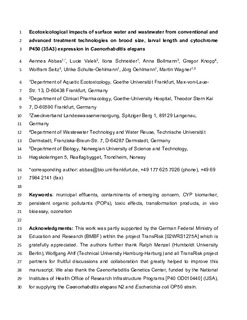| dc.contributor.author | Abbas, Aennes | |
| dc.contributor.author | Valek, Lucie | |
| dc.contributor.author | Schneider, Ilona | |
| dc.contributor.author | Bollmann, Anna | |
| dc.contributor.author | Knopp, Gregor | |
| dc.contributor.author | Seitz, Wolfram | |
| dc.contributor.author | Schulte-Oehlmann, Ulrike | |
| dc.contributor.author | Oehlmann, Jörg | |
| dc.contributor.author | Wagner, Martin | |
| dc.date.accessioned | 2019-02-26T13:40:10Z | |
| dc.date.available | 2019-02-26T13:40:10Z | |
| dc.date.created | 2019-01-08T15:33:44Z | |
| dc.date.issued | 2018 | |
| dc.identifier.citation | Environmental science and pollution research international. 2018, 25 (14), 13868-13880. | nb_NO |
| dc.identifier.issn | 0944-1344 | |
| dc.identifier.uri | http://hdl.handle.net/11250/2587542 | |
| dc.description.abstract | Anthropogenic micropollutants and transformation products (TPs) negatively affect aquatic ecosystems and water resources. Wastewater treatment plants (WWTP) represent major point sources for (micro)pollutants and TPs in urban water cycles. The aim of the current study was to assess the removal of micropollutants and toxicity during conventional and advanced wastewater treatment. Using wild-type and transgenic Caenorhabditis elegans, the endpoint reproduction, growth, and cytochrome P450 (CYP) 35A3 induction (via cyp-35A3::GFP) were assessed. Samples were collected at four WWTPs and a receiving surface water. One WWTP included the advanced treatments: ozonation followed by granular activated carbon (GAC) or biological filtration (BF), respectively. Relevant micropollutants and WWTP parameters (n = 111) were included. Significant reproductive toxicity was detected for one WWTP effluent (31–83% reduced brood size). Three of four effluents significantly promoted the growth of C. elegans larvae (49–55% increased lengths). This effect was also observed for the GAC (34–41%) and BF (30%) post-treatments. Markedly, significant cyp-35A3::GFP induction was detected for one effluent before and after ozonation, being more pronounced for the ozonated samples (5- and 7.4-fold above controls). While the advanced treatments decreased the concentrations of most micropollutants, the observed effects may be attributed to effects of residual target compounds and/or compounds not included in the target chemical analysis. This highlights the need for an integrated assessment of (advanced) wastewater treatment covering both biological and chemical parameters. | nb_NO |
| dc.language.iso | eng | nb_NO |
| dc.publisher | Springer Verlag | nb_NO |
| dc.title | Ecotoxicological impacts of surface water and wastewater from conventional and advanced treatment technologies on brood size, larval length, and cytochrome P450 (35A3) expression in Caenorhabditis elegans | nb_NO |
| dc.type | Journal article | nb_NO |
| dc.type | Peer reviewed | nb_NO |
| dc.description.version | acceptedVersion | nb_NO |
| dc.source.pagenumber | 13868-13880 | nb_NO |
| dc.source.volume | 25 | nb_NO |
| dc.source.journal | Environmental science and pollution research international | nb_NO |
| dc.source.issue | 14 | nb_NO |
| dc.identifier.doi | 10.1007/s11356-018-1605-2 | |
| dc.identifier.cristin | 1652674 | |
| dc.description.localcode | This is a post-peer-review, pre-copyedit version of an article published in Environmental Science and Pollution Research. Locked until 6 March 2019 due to copyright restrictions. The final authenticated version is available online at: http://dx.doi.org/10.1007/s11356-018-1605-2. | nb_NO |
| cristin.unitcode | 194,66,10,0 | |
| cristin.unitname | Institutt for biologi | |
| cristin.ispublished | true | |
| cristin.fulltext | postprint | |
| cristin.qualitycode | 1 | |
